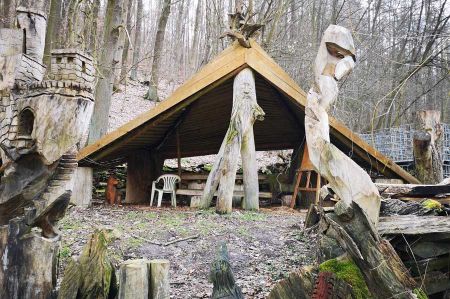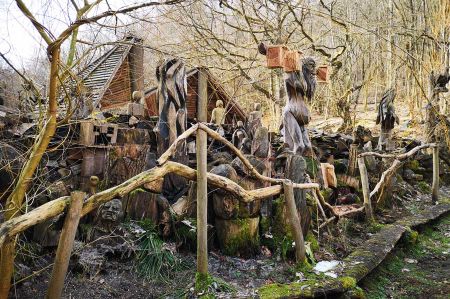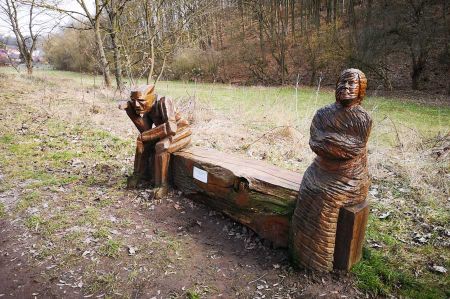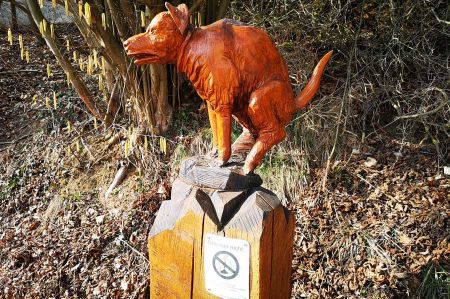Wood carving - an encounter with wood art in Garnbach
- Written by Portal Editor
We were on our way from Roßleben-Wiehe to the small street village of Garnbach in the Kyffhäuserkreis in Thuringia, which despite its only about 200 inhabitants has a certain degree of popularity, because, as we were told, this is a regional stronghold of the art of wood carving.
Now everyone can, in memory of their own youth, get a first picture of the art of wood carving, because carving requires short-fiber, homogeneous types of wood, which are numerous in the Thuringian Forest. There is the popular, relatively soft linden wood, with which detailed, fine carvings can be made. The soft green wood of deciduous trees such as hazelnut, birch, alder, ash, poplar, linden or willow is so soft that even children can easily work with it. So also a material for semi-professional carvers. The hard boxwood, on the other hand, already much harder and more demanding, is often used for detailed carvings. Light maple wood is also used quite often in carving. Stone pine is soft, but it has many knots and darkens over time. Instead, the stone pine spreads a pleasant scent, which many, transformed into sculptures, later like very much in the living room.
Carving with a knife - not just for boys
 Carving begins with the very little ones, because who does not remember their first carving knife and the warning words of their mother, but please exercise the necessary caution. Later, the instruction takes place in the handicraft class, whereby numerous tools are used, be it chisels, gouges or even saws. And that's how the first little works of art are created.
Carving begins with the very little ones, because who does not remember their first carving knife and the warning words of their mother, but please exercise the necessary caution. Later, the instruction takes place in the handicraft class, whereby numerous tools are used, be it chisels, gouges or even saws. And that's how the first little works of art are created.
With the advancement of technology, especially with regard to the handling of tools, the chainsaw also received a new field of activity: the art of chainsaws or chainsaw carving. Well, one or the other may think that working wood with a chainsaw is no art in the sense of the word. Anyone can do that. Far from it, as the examples of modern wood art later on by the wayside should show.
By the way: carvers who work with a chainsaw also like to use brown elm wood, which has a beautiful wood pattern. Other wood carvings are poplar, birch, oak, white pine and Swiss stone pine as well as various fruit woods. Many woods require a long drying time in order to keep the tendency to tear as low as possible.
Chainsaw artists have been trying their hand at this since the 1950s
 The oldest records of chainsaw artists date back to the 1950s, including artists Ray Murphy and Ken Kaiser. In 1952, Ray Murphy used his father's chainsaw to carve his name into a piece of wood. In 1961, Ken Kaiser created 50 carvings for the Trees of Mystery. Many new artists began experimenting with chainsaw carving, including Brenda Hubbard, Judy McVay, Don Colp, Cherie Currie (former Runaways singer), Susan Miller, Mike McVay, and Lois Hollingsworth.
The oldest records of chainsaw artists date back to the 1950s, including artists Ray Murphy and Ken Kaiser. In 1952, Ray Murphy used his father's chainsaw to carve his name into a piece of wood. In 1961, Ken Kaiser created 50 carvings for the Trees of Mystery. Many new artists began experimenting with chainsaw carving, including Brenda Hubbard, Judy McVay, Don Colp, Cherie Currie (former Runaways singer), Susan Miller, Mike McVay, and Lois Hollingsworth.
At that time, chainsaw carvers began loading their carvings on the back of their trucks and functioning as traveling galleries. The art form really began to grow in the 1980s when Art Moe gained a lot of attention to the craft at the World Lumberjack Championships in Hayward, Wisconsin.
 This event was broadcast nationally on TV. The addition of carving competitions from the west coast to the east coast brought carvers together to test their skills and learn from each other. The first Chainsaw Carving World Championships took place in 1987 and were won by the then 24-year-old Barre Pinske.
This event was broadcast nationally on TV. The addition of carving competitions from the west coast to the east coast brought carvers together to test their skills and learn from each other. The first Chainsaw Carving World Championships took place in 1987 and were won by the then 24-year-old Barre Pinske.
Although the general impression from the audience is that it is largely performance art (due to the noise, sawdust and very quick carving results) there are some chainsaw carvers who are now making stunning works of art, including in Germany. These jobs can be done in a fraction of the time that would normally be expected if only traditional tools such as mallets and furrows were used. Although many carvers continue to use other tools besides the chainsaw, the chainsaw remains the main tool for at least roughly preparing the outlines.
How different the results are is shown more than clearly by the row of contemporary chainsaw carvings on the wayside.
Please read as well:
A blackbird tries its hand at the tits dumplings
The Ohrid Lake and its bubbling underground springs
-
 Sculptures created with Chainsaw in Garnbach
Sculptures created with Chainsaw in Garnbach
Sculptures created with Chainsaw in Garnbach
Sculptures created with Chainsaw in Garnbach
-
 Sculptures created with Chainsaw in Garnbach
Sculptures created with Chainsaw in Garnbach
Sculptures created with Chainsaw in Garnbach
Sculptures created with Chainsaw in Garnbach
-
 Sculptures created with Chainsaw in Garnbach
Sculptures created with Chainsaw in Garnbach
Sculptures created with Chainsaw in Garnbach
Sculptures created with Chainsaw in Garnbach
-
 Sculptures created with Chainsaw in Garnbach
Sculptures created with Chainsaw in Garnbach
Sculptures created with Chainsaw in Garnbach
Sculptures created with Chainsaw in Garnbach
-
 Sculptures created with Chainsaw in Garnbach
Sculptures created with Chainsaw in Garnbach
Sculptures created with Chainsaw in Garnbach
Sculptures created with Chainsaw in Garnbach
-
 Sculptures created with Chainsaw in Garnbach
Sculptures created with Chainsaw in Garnbach
Sculptures created with Chainsaw in Garnbach
Sculptures created with Chainsaw in Garnbach
-
 Sculptures created with Chainsaw in Garnbach
Sculptures created with Chainsaw in Garnbach
Sculptures created with Chainsaw in Garnbach
Sculptures created with Chainsaw in Garnbach
-
 Sculptures created with Chainsaw in Garnbach
Sculptures created with Chainsaw in Garnbach
Sculptures created with Chainsaw in Garnbach
Sculptures created with Chainsaw in Garnbach
-
 Sculptures created with Chainsaw in Garnbach
Sculptures created with Chainsaw in Garnbach
Sculptures created with Chainsaw in Garnbach
Sculptures created with Chainsaw in Garnbach
-
 Sculptures created with Chainsaw in Garnbach
Sculptures created with Chainsaw in Garnbach
Sculptures created with Chainsaw in Garnbach
Sculptures created with Chainsaw in Garnbach
-
 Sculptures created with Chainsaw in Garnbach
Sculptures created with Chainsaw in Garnbach
Sculptures created with Chainsaw in Garnbach
Sculptures created with Chainsaw in Garnbach
-
 Sculptures created with Chainsaw in Garnbach
Sculptures created with Chainsaw in Garnbach
Sculptures created with Chainsaw in Garnbach
Sculptures created with Chainsaw in Garnbach
-
 Sculptures created with Chainsaw in Garnbach
Sculptures created with Chainsaw in Garnbach
Sculptures created with Chainsaw in Garnbach
Sculptures created with Chainsaw in Garnbach
-
 Sculptures created with Chainsaw in Garnbach
Sculptures created with Chainsaw in Garnbach
Sculptures created with Chainsaw in Garnbach
Sculptures created with Chainsaw in Garnbach
-
 Sculptures created with Chainsaw in Garnbach
Sculptures created with Chainsaw in Garnbach
Sculptures created with Chainsaw in Garnbach
Sculptures created with Chainsaw in Garnbach
https://www.alaturka.info/en/culture/art-craft/5321-wood-carving-an-encounter-with-wood-art-in-garnbach#sigProIde86ca7fd0f

